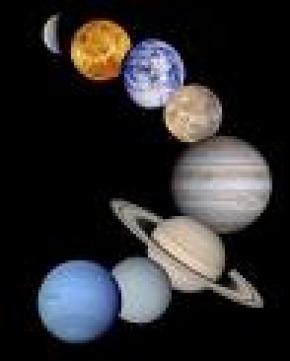The Planets in our Solar System

Planets
A planet is a large celestial object that travels around a star. There are eight planets travelling around the Sun- Mercury, Venus, Earth, Mars, Jupiter, Saturn, Uranus and Neptune. Each of the planets all have different size, composition, atmosphere and length of day and year. Terrestrial planets are planets located closest to the Sun. Their surfaces are hard and rocky unlike the next four planets that are composed of mostly gases and liquids (known as gas giants).
Planets are non-luminous. Planets don’t give off light we see them because the reflect light from the sun and other stars.
Our Planet Earth
Earth is the third planet from the Sun and the fourth largest planet. Earth is a terrestrial planet composed primarily of rock. Earth is always in constant motion and differs from the other planets because it has life and large quantities of water.
Dwarf Planets
To be considered a “planet” a celestial object must:
-Be in orbit around a star (sun)
-Have enough mass to be pulled into a stable sphere shape by gravity
-Dominate its orbit (its mass must be greater than anything else that crosses its orbit)
Dwarf planets orbit the Sun and have a spherical shape. However they do not dominate their orbits.
Five recognized dwarf planets:
1)Ceres
2)Pluto
3)Haumea
4)Makemake
5)Eris
But only two of these dwarf planets are considered dwarf planets, Pluto and Ceres. These are considered dwarf planets because they have enough detail to prove unlike all the other dwarf planets.
http://www.windows.ucar.edu/tour/link=/our_solar_system/dwarf_planets/dwarf_planets.html
this website will give you more information on Dwarf Planets
About Each of the Planets
Mercury is the closest planet to the Sun and the eighth largest. Mercury has been known since at least the time of the Sumerians (3rd millennium BC). Since it is closer to the Sun than the Earth, the illumination of Mercury's disk varies when viewed with a telescope from our perspective.
Venus is the second planet from the Sun and the sixth largest. Venus has been known since prehistoric times. It is the brightest object in the sky except for the Sun and the Moon.
Mars is the fourth planet from the Sun and the seventh largest. The planet probably got this name due to its red color. Mars is sometimes referred to as the Red Planet. Mars has been known since prehistoric times.
Saturn is the sixth planet from the Sun and the second largest.
Saturn has been known since prehistoric times.
Saturn's rings are extraordinarily thin: though they're 250,000 km or more in diameter they're less than one kilometer thick.
Jupiter is the fifth planet from the Sun and by far the largest. Jupiter is more than twice as massive as all the other planets combined (the mass of Jupiter is 318 times that of Earth). Jupiter is the fourth brightest object in the sky (after the Sun, the Moon and Venus).
Uranus is the seventh planet from the Sun and the third largest (by diameter). Uranus is larger in diameter but smaller in mass than Neptune. Uranus, the first planet discovered in modern times.
Neptune is the eighth planet from the Sun and the fourth largest. After the discovery of Uranus, it was noticed that its orbit was not as it should be in accordance with Newton's laws. It was therefore predicted that another more distant planet must be perturbing Uranus' orbit. Neptune was first observed.
Pluto orbits beyond the orbit of Neptune. It is much smaller than any of the official planets and now classified as a "dwarf planet". Pluto was discovered in 1930
